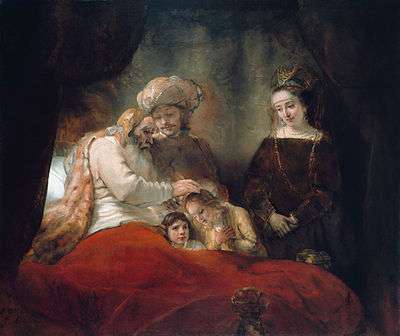Jacob Blessing the Sons of Joseph
 | |
| Artist | Rembrandt |
|---|---|
| Year | 1656 |
| Medium | Oil on canvas |
| Dimensions | 173 cm × 209 cm (68 in × 82 in) |
| Location | Schloss Wilhelmshöhe, Kassel, Hesse, Germany |
Jacob Blessing the Sons of Joseph is a 1656 oil painting by Dutch artist Rembrandt van Rijn. It is said to have almost “a sculptural surface with a translucent glaze over paint”.[1] This piece is housed in the Museumslandschaft Hessen Kassel in Kassel, Germany.[2]
Background
Jacob Blessing the Sons of Joseph shows a scene from the Old Testament book of Genesis, Chapter 48.[3] In this scene, Joseph brings his two sons (Manasseh and Ephraim) to his dying father Jacob so that they can receive the family blessing. According to tradition, the eldest son is blessed with the patriarch’s right hand.[4] However, Jacob deliberately crossed his arms and put his right hand on Ephraim’s (the younger son’s) head and his left hand on Manasseh’s (the oldest son’s) head. Joseph was displeased and thought that his father was making a mistake. When Joseph tried to correct his father, Jacob refused and told Joseph that he was purposefully blessing the younger son.
Differences
This painting only shows the blessing of Ephraim. The arms aren’t crossed and Manasseh isn’t being blessed simultaneously, as the text implies. In addition, Rembrandt omits the argument between Joseph and Jacob. In fact, the tenderness and warmth of the familial interaction seems to suggest that the blessing of the younger son was the original intention. Lastly, Rembrandt included the mother of the children, Asenath.
Asenath
Asenath was the daughter of an Egyptian priest. According to chapter 41 in the book of Genesis, she was given to Joseph by the pharaoh, himself. The purpose of adding Asenath to the painting is unknown. However, some think that Rembrandt was incorporating 17th century Dutch culture into the painting. Dutch wives were beginning to be viewed more as colleague to their husbands. With this mindset, it would only be logical that Asenath would be present at such an important event as the blessing of her children.[5]
Artistic qualities
Rembrandt is famous for his use of light and shadow (Chiaroscuro) and Jacob Blessing the Sons of Joseph is not an exception to the rule.[6] This draws attention to the main characters of Jacob, Joseph, Ephraim, Manasseh, and Asenath while obscuring the background. In particular, there seems to be a halo surrounding Ephraim as he is being blessed. Also notable is the prominent colors that Rembrandt used. The yellows, browns, and reds give the painting a mood that is “both intimate and sacred, tender and solemn”.[7]
References
- ↑ "Crawford, Amy An Interview with Stephanie Dickey, author of Rembrandt at 400 Smithsonian Magazine, December 1, 2006 Retrieved 2012-01-27". Smithsonianmag.com. Retrieved 2012-12-04.
- ↑ "Online-Database of Old Master Paintings in Kassel. Retrieved 2016-01-21". Museum-kassel.de. Retrieved 2016-01-21.
- ↑ "Bible Gateway, Genesis 48". Biblegateway.com. Retrieved 2012-12-04.
- ↑ "Art and the Bible". Artbible.info. Retrieved 2012-12-04.
- ↑ Buettner, Jamie Family Benediction: The role of Asenath in Rembrandt's Jacob Blessing the Sons of Joseph Hindsight, California State University-Fresno, Spring 2011
- ↑ "Bertman, Sandra L. Jacob Blessing the Sons of Joseph Literature Arts and Medicine Database, NYU School of Medicine, updated June 29, 2006. Retrieved 2012-01-27". Litmed.med.nyu.edu. 1999-05-03. Retrieved 2012-12-04.
- ↑ "Krén, Emil Jacob Blessing the Children of Joseph, Web Gallery of Art. Retrieved 2012-01-27". Wga.hu. Retrieved 2012-12-04.